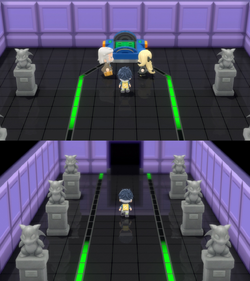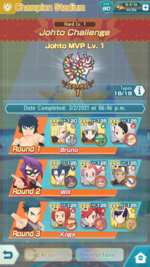Hall of Fame
- For the books, see Pokémon: Sinnoh Hall of Fame and Pokémon Hall of Fame (book).

The Hall of Fame (Japanese: 殿堂入り Induction to the Hall of Fame) is a record kept by the Pokémon League of all the Pokémon Trainers who have ever beaten the Pokémon Champion.
In Generations I and II, and in Pokémon FireRed and LeafGreen, a Hall of Famer is a Trainer or any of their Pokémon who entered the Hall of Fame. In the internal data of Generation II games, there is an unused feature that would refer to a player who entered the Hall of Fame 200 times as a HOF Master.
Various data regarding the victorious Trainer is recorded. The Hall of Fame was in a room accessible from the Champion's room prior to Generation VII. It may be accessed by people who have entered it by way of PC.
In the core series
Data recorded
In each game, data is recorded into the PC, which is also shown during the games' ending scene. This is a list of which data is visible on the Hall of Fame PC option.
Generation I
Hall of Fame records are stored per individual Pokémon. This means that a single member team is given a single record, while a six-member team is given six records. Each uniquely indexed record holds the Pokémon's species, level, and nickname. The Pokémon's type is also displayed; however, this value is generated from the record's species index itself.
All Generation I games store the player's 50 most recent records in ascending order. Any further records overwrite the oldest record present. For example, if a player were to defeat the Elite Four 51 times, feats 2 through 51 would be displayed in that order, with 1 having been overwritten. This storage allows for a maximum of 300 Pokémon records to be displayed in the Hall of Fame at any given time.
In addition, the player's name, playing time, money, sprite, and number of Pokémon obtained are displayed during the ending scene, along with each team member's unique record beforehand. Professor Oak also evaluates the player's Pokédex before the credits roll.
Generation II
Hall of Fame records are again stored per individual Pokémon. Each uniquely indexed record now holds the Pokémon's species, level, IVs, Trainer ID number and nickname. Although the IVs are not visible, they are used to display the Pokémon's gender, alternate color, and Unown form, if any of the three apply to the given specimen. The Pokémon's index number is also displayed; however, this value is generated from the record's species index itself.
All Generation II games store the player's 30 most previous feats in a descending order. Any further feats would again delete records in a First In, First Out method. For example, if a player were to defeat the Elite Four 31 times, feats 31 through 2 would be displayed in that order, with 1 having been overwritten. This storage allows for a maximum of 180 Pokémon records to be displayed in the Hall of Fame at any given time.
In addition, the player's name, Trainer ID number, playing time, sprite, and number of Pokémon obtained are displayed during the ending scene, along with each team member's unique record beforehand. Professor Oak also evaluates the player's Pokédex before the credits roll.
Generation III
Hall of Fame records are now stored per each team, so as to save time traversing through records. This means that a single member team is given a single record, while a six-member is team is also given a single record. Each indexed record holds an entire team's data, with each unique team member entry consisting of its species, level, nickname, personality value, and Trainer ID number. Personality values work exactly like IVs in Generation II, in that they are not visible, yet are used to display the Pokémon's gender, alternate color, and Unown and/or Spinda form, if any of the these apply to the given specimen. The Pokémon's index number is once again displayed; however, this value is generated from the record's species index itself.
All Generation III games store the player's 50 most previous feats in a descending order. Any further feats would delete records in a First In, First Out method. For example, if a player were to defeat the Elite Four 51 times, feats 51 through 2 would be displayed in that order, with 1 having been overwritten. This storage allows for a maximum of 50 team records, each with a maximum of 300 Pokémon total, to be displayed in the Hall of Fame at any given time.
In addition, the player's name, Trainer ID number, playing time and sprite are displayed during the ending scene, along with each team member's unique record beforehand. Unlike previous generations, however, each game's regional Professor will not evaluate the Pokédex. Instead, the message LEAGUE CHAMPION! CONGRATULATIONS! is displayed before the credits roll.
Generation IV
Hall of Fame records are again stored per each team, so as to save time traversing through records. Each indexed record holds the date the feat took place, as well as an entire team's data, with each unique team member entry consisting of its species, level, nickname, personality value, Trainer name and all four learned moves. Personality values are not visible, yet are used to display the Pokémon's gender, alternate color, and form, if any of the three apply to the given specimen.
All Generation IV games store the player's 30 most previous feats in a descending order. Any further feats would delete records in a First In, First Out method. For example, if a player were to defeat the Elite Four 31 times, feats 31 through 2 would be displayed in that order, with 1 having been overwritten. This storage allows for a maximum of 30 team records, each with a maximum of 180 Pokémon total, to be displayed in the Hall of Fame at any given time.
In addition, the player's name, Trainer ID number, playing time and sprite and the message League Champion! Congratulations! are displayed during the ending scene, along with each team member's unique record beforehand.
Additionally, when a team member is displayed during the ending scene, its original catching location will be displayed. Whether this piece of information is stored within each team member's Hall of Fame record or not has yet to be researched.
Generation V

|
This section is incomplete. Please feel free to edit this section to add missing information and complete it. Reason: Needs research on how the Hall of Fame data is stored |
In addition to recording the player's party after defeating the Champion in all games of Generation V, the Hall of Fame in Pokémon Black and White also records data after the player defeats Ghetsis. A maximum of 15 entries can be recorded at any time, as well as the First Game Clear. The data is again deleted using the First In, First Out method. The data is stored in the "Records" section of the PC. Each entry includes the date the player entered the Hall of Fame, their Pokémon's nickname, gender, level, species, Original Trainer, and moves.
Generation VI
After defeating the Elite Four, the player's party is saved in the Hall of Fame. Stored data for each party member includes species, gender, level, nickname, Original Trainer, moves, and held items. Similarly to Generation V, a maximum of 15 Elite Four clears can be recorded at any time, as well as the First Game Clear. The data is deleted using the First In, First Out method.
Generation VII
In Generation VII the Hall of Fame is no longer an actual place, nor can it be recalled at a PC. Instead, when Hau or Professor Kukui is defeated in battle, the screen transitions into each Pokémon in the party, and their levels, displayed as multicolored shooting stars before transitioning to the player looking around at the stars, with the message Congratulations! You are the first-ever Champion of Alola! or Congratulations! You defended your title! (if the last battle was a title defense).
A Golfer standing near the Pokémon League entrance replaces the PC function to recall data from victorious teams, but the only data that's stored in this generation are the species names, and only for two saved teams: the first victory, and the most recent one.
Generation VIII
In Pokémon Sword and Shield, the Hall of Fame is once again no longer an actual place. Instead, the title screen will now be updated to showcase each party member of the player's team after defeating Leon. In addition, each Pokémon will receive a Galar Champion Ribbon that solidifies the player having entered the Hall of Fame. Since Leon officially loses his title and position as Champion in these games, this will be the only formal Hall of Fame indictment. However, this title screen may still be updated by completing a Champion tournament.
Generation IX
In Pokémon Scarlet and Violet, the Hall of Fame is mentioned in the description of the Paldea Champion Ribbon received by the player's party after either defeating Geeta or winning the Academy Ace Tournament. Additionally, a pamphlet titled "Hall of Fame Badges: A Record" is located on the top floor of Naranja AcademyS/Uva AcademyV. Initially, only Professor SadaS/Professor TuroV has their name listed. However, following the completion of the main story, the names of Nemona, Arven, Penny, and the player are added to the book. There is no sequence of any kind to showcase the Pokémon that have beaten Geeta.
Rewards
Once the player has entered the Hall of Fame, few to several rewards are unlocked, depending of the version played.
Generation I
- The player is granted access to Cerulean Cave, while in Pokémon FireRed and LeafGreen, the Generation III remakes of Pokémon Red and Green, it is one of the requirements needed to enter Cerulean Cave.
Generation II
- In Generation II and Pokémon HeartGold and SoulSilver, the player is given an S.S. Ticket for the S.S. Aqua, effectively giving them access to the Kanto region.
Generation III
- In Pokémon Ruby, Sapphire, and Emerald:
- A star will be placed on the player's Trainer Card, changing its color.
- A Champion Ribbon will be given to all of the player's Pokémon that get into the Hall of Fame.
- The player will be granted a Beldum in Steven's house in Mossdeep City.
- In Pokémon Ruby and Sapphire:
- The Sky Pillar will be unlocked, allowing the player to catch Rayquaza.
- LatiosR/LatiasS will begin roaming Hoenn.
- The player can board the S.S. Tidal to visit the Battle Tower.
- In Pokémon Emerald:
- Adverse weather may also be reported in some areas, giving the player a chance to access Marine Cave and Terra Cave to catch Kyogre and Groudon, respectively.
- The player can access the Altering Cave, Desert Underpass, and the Trainer Hill.
- Steven Stone will be available for battle in the Meteor Falls.
- Latios or Latias will begin roaming Hoenn after the player responds to his/her mother which colored-dragon was seen roaming. The other dragon will be available in Southern Island.
- The player can board the S.S. Tidal to visit the Battle Frontier.
Generation IV
- In Pokémon Diamond, Pearl, and Platinum:
- A star will be placed on the player's Trainer Card, changing its color.
- A Sinnoh Champ Ribbon will be given to all of the player's Pokémon that get into the Hall of Fame.
- The player can board the S.S. SinnohDP/S.S. SpiralPt, granting access to the Battle Zone.
- The rival's team at the Fight Area will be ten levels higher once the player enters the Hall of Fame twentyDP/tenPt times.
- In Pokémon Platinum, after the player has entered the Hall of Fame a total of twenty times, the rival's team will now be twenty levels higher.
Generation V
- In Pokémon Black and White, the player receives additional PC wallpapers to commemorate the conquest of the Unova Elite Four and Team Plasma, and another set for defeating the Elite Four in rematches and the first defeat of Alder. In Pokémon Black 2 and White 2, one set of wallpapers is unlocked upon defeating Iris.
- In Pokémon Black 2 and White 2 the player is allowed to:
- Go back to the Giant Chasm to catch Kyurem and obtain the DNA Splicers.
- Access Marvelous Bridge, Tubeline Bridge, and Skyarrow Bridge.
Generation VI
- In X and Y, a Champion Ribbon will be given to all of the player's Pokémon that get into the Hall of Fame.
- The player is granted access to the Unknown Dungeon where Mewtwo can be captured, along with its respective Mega Stone.
- Zygarde and Moltres, Zapdos, or Articuno, depending on the starter chosen at the start of the game, are also available for capture.
- Outside the player's house, Shauna will offer to trade any of the player's Pokémon for the unevolved form of her starter Pokémon.
- Upon reaching the Lumiose City train station, access to Kiloude City, and by extension, the Battle Maison, Friend Safari, and rematches with the rival, will be granted.
- After completing certain conditions, the player's Mega Ring can be upgraded, and a sidequest involving Looker can be initiated in Lumiose City.
- In Omega Ruby and Alpha Sapphire, a Champion Ribbon will be given to all of the player's Pokémon that get into the Hall of Fame. After the first time, the Delta Episode starts, and Birch gives the player a Johto starter. The second time, the player is given a Sinnoh starter.
Generation VII
- In Sun and Moon, a Champion Ribbon will be given to all of the player's Pokémon that get into the Hall of Fame.
- All Pokémon will obey the player, regardless of the Pokémon's current level.
- The player is allowed to battle the Guardian deities in their respective ruins.
- The Ultra Beast and Eevee users sidequests become available.
- The eastern portion of Poni Island can be accessed, including the Battle Tree at the northernmost point.
- Gladion gifts the player a Type: Null at Aether Paradise.
- The Altar of the SunneS/Altar of the MooneM has a portal that can be used to invert the time of day and allow the player to obtain a Cosmog in the time inverted world's Lake of the SunneS/Lake of the MooneM.
- Subsequent Champion battles at the Alola Pokémon League involve the player defending their title from various other Alola Trainers.
- During its distribution event, Magearna can be claimed.
Generation VIII
- In Sword and Shield, a Champion Ribbon will be given to all of the player's Pokémon that get into the Hall of Fame.
- The player can visit Leon's house to receive a Charmander that he left behind for them.
- The player can now partake in a post-game quest involving Zacian and Zamazenta.
- All Wild Pokémon in the Wild Area and the Isle of Armor have their levels raised to level 60 or higher. In addition, the fog weather condition will now appear on various days.
- Calyrex is now able to be captured in the Crown Tundra.
- Mustard will now allow the player to partake in a quest to access Urshifu's Gigantamax form.
Layout

|
This section is incomplete. Please feel free to edit this section to add missing information and complete it. Reason: Missing all layouts from Generations V-VII |
Generations I-III
| Red | Blue | Yellow | Gold | Silver | Crystal | Ruby | Sapphire | Emerald | FireRed | LeafGreen |
|---|---|---|---|---|---|---|---|---|---|---|
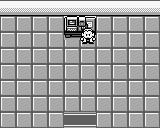
|

|
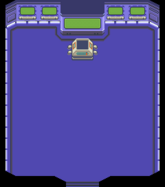
|
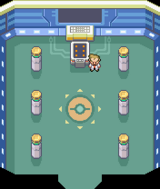
| |||||||
Generation IV
| Diamond | Pearl | Platinum | HeartGold | SoulSilver |
|---|---|---|---|---|

| ||||
Generation VIII
| Brilliant Diamond | Shining Pearl |
|---|---|
Healing Pokémon
In Generation I games, there is no automatic Pokémon healing at the Hall of Fame. When the player resumes a Generation I game after entering the Hall of Fame, the Pokémon will still have their lost HP, PP, their status conditions (if any), and any fainted Pokémon will remain fainted.
From Generation II onwards, all Pokémon in the party are automatically healed when the player enters the Hall of Fame.
Glitches
- In the Generation I games, if the player encounters MissingNo. or other glitch Pokémon, the Hall of Fame data may be corrupted by a glitch in the game. When MissingNo. has been seen on the save file, the player's Hall of Fame is badly corrupted with entirely different Pokémon, which will often consist of glitched characters and names. Players can often see particular Pokémon in the Hall of Fame, whether they have seen them in the Pokédex or not. This effect also works in Pokémon Yellow when encountering glitch Pokémon through the Mew glitch. However, a way to avoid the effects of this glitch is to encounter MissingNo. or any other glitch Pokémon before entering the Hall of Fame, because encountering a MissingNo. only affects the teams already registered in the Hall of Fame. Players can also defeat the Elite Four multiple times after having encountered MissingNo., as the game will automatically overwrite older Hall of Fame entries after the Elite Four is defeated 20 times.
- In Pokémon Red and Green, performing the Dokokashira door glitch allows the player to quickly complete the game by forcing the next door to take them to another location; this can include the Hall of Fame room. This extremely hazardous and game-breaking glitch was removed from Pokémon Blue, causing it to not be present in the translated Pokémon Red and Blue.
- In earlier versions of Pokémon Omega Ruby and Alpha Sapphire, the game would sometimes freeze after recording the player's team data in the Hall of Fame; this glitch was patched out in the Version 1.2 update on December 3, 2014, 12 days after the games' initial release.
Artwork

|
| Concept art from the Let's Go, Pikachu and Eevee! Super Music Collection |
In other games
Pokémon Masters EX
Like in the core series games, in Pokémon Masters EX, players may enter the Hall of Fame after defeating the Elite Four and Champion in the Champion Stadium at Hard difficulty. Unlike in the core series games however, players are required to use different sync pairs when challenging each individual Elite Four member or Champion; thus, 5-15 sync pairs can be registered at the Hall of Fame. After the Champion is defeated, a short animation will play showing the sync pair(s) that defeated the Champion before the message "Congratulations! Hall of Fame Entry No. #" appears, with the # indicating the number of times the player has entered the Hall of Fame overall within the region in rotation.
The Hall of Fame lists the date and time the Champion Stadium was cleared as well as the sync pairs that defeated each individual Elite Four member or Champion in the order they were faced. Only the region in which the Champion Stadium is running is reported for the Hall of Fame.
Should the player succeed in entering the Hall of Fame with 18 different types of sync pairs, they may obtain an MVP Medal for the region in rotation, after which they may participate in the Master Mode of the Champion Stadium.
In the anime
Main series
The Hall of Fame's only appearance in the anime was in Enter the Dragonite. After beating Drake, the Orange Crew Supreme Gym Leader, Ash earned the title of "Honored Trainer"* and a spot in the Palace of Victory, which is also known as the Orange League Hall of Fame. A photo of the winning Trainers and their Pokémon are kept on display.
In Gathering the Gang of Four!, Scott revealed that any Trainer who successfully defeats the Battle Frontier is entered into the Hall of Fame and becomes a Frontier Brain candidate. After earning his final Symbol by defeating Brandon in the next episode, Ash entered the Battle Frontier Hall of Fame, but turned down the offer for Frontier Brain candidacy.
Pokémon Origins
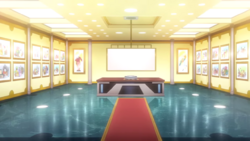
The Hall of Fame appeared in File 4: Charizard after Red defeated Blue and became the Pokémon League Champion. Much like in the games, Red was led to the Hall of Fame by Professor Oak, after which Red's Pokémon's data was recorded and displayed on a screen. The Hall of Fame contained numerous portraits of all the previous Champions and their Pokémon teams.
Trivia
- The "Congratulations" screen in the Generation V games shows the player with one of their Pokémon; After showing one battle animation cycle, it rotates the Pokémon off-screen to the left and the next Pokémon takes its place from the right. This is similar to what occurs in the title screen of Pokémon Red, Green, and Blue.
- In Generation II, the Hall of Fame counter stops at 200 despite coding for a unique message of "HOF Master!" on the 201st entry into the Hall of Fame. This error occurs due to a coding oversight that causes the counter to stop at 200 entries instead of allowing the count to go past 201 times.[citation needed]
In other languages
| ||||||||||||||||||||||||||||||||||||||||||||||

|
The Pokémon League | 
| |
|---|---|---|---|
| Participation Trainer • Battle • Gym Leaders Gyms • Badges • Referee Championship matches Elite Four • Orange League Champion League Pokémon League Conferences Indigo • Silver • Ever Grande • Lily of the Valley Vertress • Lumiose • Manalo |
Regional Pokémon Leagues Indigo • Orange* • Johto • Hoenn • Sinnoh Unova (BB) • Kalos • Alola • Galar • Paldea Areas of jurisdiction Pokémon League Reception Gate • Hall of Fame Palace of Victory • Cerulean Cave • Area Zero Others Admissions Exam • Pokémon Association PIA • World Coronation Series (Masters Eight Tournament) | ||

|
This article is part of Project Locations, a Bulbapedia project that aims to write comprehensive articles on every location in the Pokémon world. |

